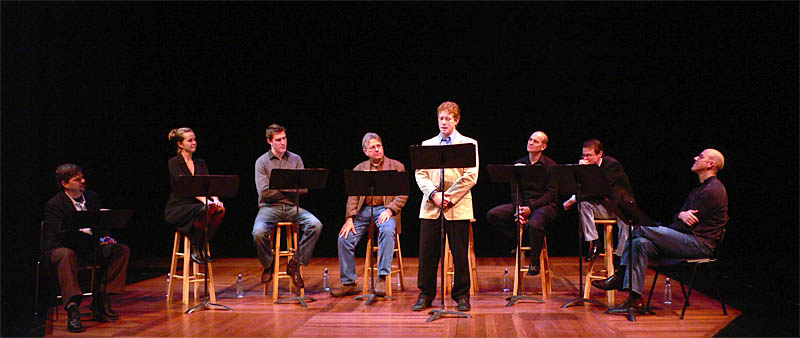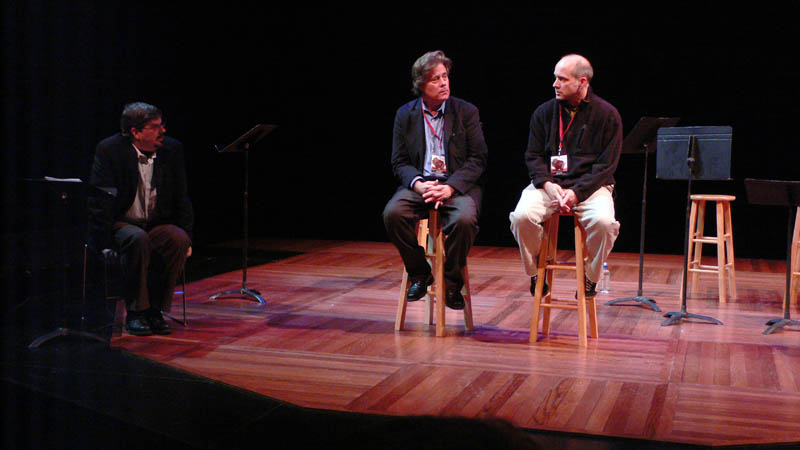When historians search for a paradigmatic figure who embodied America’s old, pre-9/11 relationship with the Arab world, an obvious candidate will be Saudi Arabia’s swaggering ambassador to Washington from 1983 to 2005, Prince Bandar bin Sultan. He was the Gatsby of foreign affairs: entertaining Washington’s elite at his mansion overlooking the Potomac; exchanging secret favors with a string of presidents from Ronald Reagan to George W. Bush; lobbying for Saudi weapons purchases so effectively that he trounced even AIPAC, the pro-Israel lobby group; operating as a deniable arm of the CIA in covert operations around the world.
“The Only Thing”


The Madison Rep’s New Play Festival: The Only Thing by Eric Simonson, based on David Maraniss’ excellent “When Pride Still Mattered“.
Simonson’s approach to Lombardi is clever and interesting. There’s another reading Saturday evening, 11/11/2006 @ 7:00p.m. GO!
A Closer Look at Plunging Circulation
As was widely reported, the six-month circulation numbers for U.S. newspapers released earlier this week carried plenty of bad news: an industry-wide tumble year-to-year of 2.8% daily and 3.4% on Sunday. There were much deeper losses in big metro markets like Boston, Los Angeles and Miami.
As grim as those numbers are, a deeper look into the Audit Bureau of Circulations (ABC) reports and into some online data released by the Newspaper Association of America (NAA), makes the overall economic picture even a little bleaker.
True to their word, most companies and individual papers continue to burn so-called “junk” circulation, such as the category called “other paid” as well as third-party or bulk sales, all of it of little value to advertisers. That would support the idea that the business is pruning numbers, but improving the quality of its circulation.
…
Take the six largest papers of Lee Enterprises (Lee owns half of Capitol Newspapers), the best circulation performer among public companies. Together they achieved a highly respectable daily loss of just 0.3%. However those same papers lost 25,000 circulation among those paying 50 percent or greater of the full price of the paper, a drop of 4.1%. At the same time, it added 13,500 in the 25 to 50 percent category, a 43.9% increase. That means the papers had significant losses among subscribers paying a higher percentage of the full price while adding readers who paid more steeply discounted rate
Interesting MetaData: Madison Air Travel Searches
Rhetoric & Reality: Mapping Congress’ Voting Records on Technology
Ever since the mid-1990s, politicians have grown fond of peppering their speeches with buzzwords like broadband, innovation and technology.
John Kerry, Al Gore and George W. Bush have made fundraising pilgrimages to Silicon Valley to ritually pledge their support for a digital economy.
But do politicos’ voting records match their rhetoric? To rate who’s best and who’s worst on technology topics before the Nov. 7 election, CNET News.com has compiled a voter’s guide, grading how representatives in the U.S. Congress have voted over the last decade.
While many of the scored votes centered on Internet policy, others covered computer export restrictions, H-1B visas, free trade, research and development, electronic passports and class action lawsuits. We excluded the hot-button issue of Net neutrality, which has gone only to a recorded floor vote in the House of Representatives so far, because that legislation has generated sufficient division among high-tech companies and users to render it too difficult to pick a clear winner or loser.
The results were surprisingly mixed: In the Senate, Republicans easily bested Democrats by an average of 10 percent. In the House of Representatives, however, Democrats claimed a narrow but visible advantage on technology-related votes.
John Kerry finished second last in the Senate. Locally, Ron Kind, Mark Green and Tom Petri “scored” above 50%. Senate / House scoring methodology. For example, both Senators Feingold and Kohl voted for the National ID card and linking databases while Representative Baldwin voted against it.
Draining Canada First
Petroleum and Natural Gas Watch
Michael Vickerman, RENEW Wisconsin
Vol. 5, Number 8
November 2, 2006
Sating America’s prodigious energy appetite depends on the continued availability of Canadian energy sources. About 25% of the crude oil and 80% of the natural gas imported into the United States come from our very accommodating neighbor to the north. More than half of the fuel pumped out of Canadian wells heads south to keep us Yankees warm and happily tooling about on our highways.
Even though the Canadian economy is no less dependent on hydrocarbon energy than ours, Canada has been drilling as many wells as necessary to keep the high-maintenance American economy humming. If this pedal-to-the-metal production policy were applied to a non-strategic product like, say, maple syrup, few people would care about the consequences. But there is nothing on the horizon to replace the nonrenewable high-density energy sources that Canada so generously sends our way.
This begs the question: how long can Canada go on behaving like America’s most compliant energy colony?
Not very long, according to David Hughes, a petroleum geologist with the Geological Survey of Canada. Speaking before the World Peak Oil Conference held in Boston last week, Hughes painted a remarkably pessimistic picture of Canada’s energy future, especially regarding natural gas.
State by State Voting Technology Roundup
State contracted with Accenture in 2004 and launched its database before the September 2006 primary; legality of contract was challenged in court and company was forced to expand state access to proprietary database software. Wisconsin law previously required voter registration only in municipalities with a population over 5,000, which works out to about one-sixth of them; as of January 2006, state law required that all voters register. (Election Day registration is available.) The Century Foundation characterizes Wisconsin’s poll-worker training efforts as unsatisfactory [TCF State report PDF]; those working with the system, in turn, say the new software is slower and harder to use than the old software.
The Next Capitalism
When he died in 1848, John Jacob Astor was America’s richest man, leaving a fortune of $20 million that had been earned mainly from real estate and fur trading. Despite his riches, Astor’s business was mainly a one-man show. He employed only a handful of workers, most of them clerks. This was typical of his time, when the farmer, the craftsman, the small partnership and the independent merchant ruled the economy. Only 50 years later, almost everything had changed. Giant industrial enterprises — making steel, producing oil, refining sugar and much more — had come to dominate.
The rise of big business is one of the seminal events in American history, and if you want to think about it intelligently, you consult historian Alfred D. Chandler Jr., its pre-eminent chronicler. At 88, Chandler has retired from the Harvard Business School but is still churning out books and articles. It is an apt moment to revisit his ideas because the present upheavals in business are second only to those of a century ago.
Until Chandler, the emergence of big business was all about titans. The Rockefellers, Carnegies and Fords were either “robber barons” whose greed and ruthlessness allowed them to smother competitors and establish monopolistic empires. Or they were “captains of industry” whose genius and ambition laid the industrial foundations for modern prosperity. But when Chandler meticulously examined business records, he uncovered a more subtle story. New technologies (the railroad, telegraph and steam power) favored the creation of massive businesses that needed — and, in turn, gave rise to — superstructures of professional managers: engineers, accountants and supervisors.
This is Baghdad. What Could be Worse?
UW-Madison Grad Anthony Shadid:
It had been almost a year since I was in the Iraqi capital, where I worked as a reporter in the days of Saddam Hussein, the U.S.-led invasion in 2003, and the occupation, guerrilla war and religious resurgence that followed. On my return, it was difficult to grasp how atomized and violent the 1,250-year-old city has become. Even on the worst days, I had always found Baghdad’s most redeeming quality to be its resilience, a tenacious refusal among people I met over three years to surrender to the chaos unleashed when the Americans arrived. That resilience is gone, overwhelmed by civil war, anarchy or whatever term could possibly fit. Baghdad now is convulsed by hatred, paralyzed by suspicion; fear has forced many to leave. Carnage its rhythm and despair its mantra, the capital, it seems, no longer embraces life.
“A city of ghosts,” a friend told me, her tone almost funereal.
NCAA: Rein in Sports Spending
In a task-force report released Monday by NCAA president Myles Brand, Division I schools were encouraged to rein in spending on sports – but there aren’t any requirements everyone must adhere to or punishments if they don’t.
“In the case of academic reform, we had a hammer – namely, by teams not conforming, we could take away scholarships and, if that failed, we could keep them out of the Final Four and postseason. That’s heavy duty. That’s a sledgehammer,” Brand said after speaking at the National Press Club. “The fact is, we don’t have that for fiscal responsibility in intercollegiate athletics.”
The task force of about 50 school presidents and chancellors was formed in January 2005, and the report’s release comes as the NCAA is preparing its response to an Oct. 3 letter from Rep. Bill Thomas, R-Calif., chairman of the tax-writing House Ways and Means Committee. Thomas asked the NCAA to justify its tax-exempt status and sought a reply by the end of October; the NCAA received a two-week extension.
I’ve gone to a variety of sporting events around the country over the past 25 years. It is interesting to observe the explosion in sponsorships, luxury boxes and facilities around college athletics.